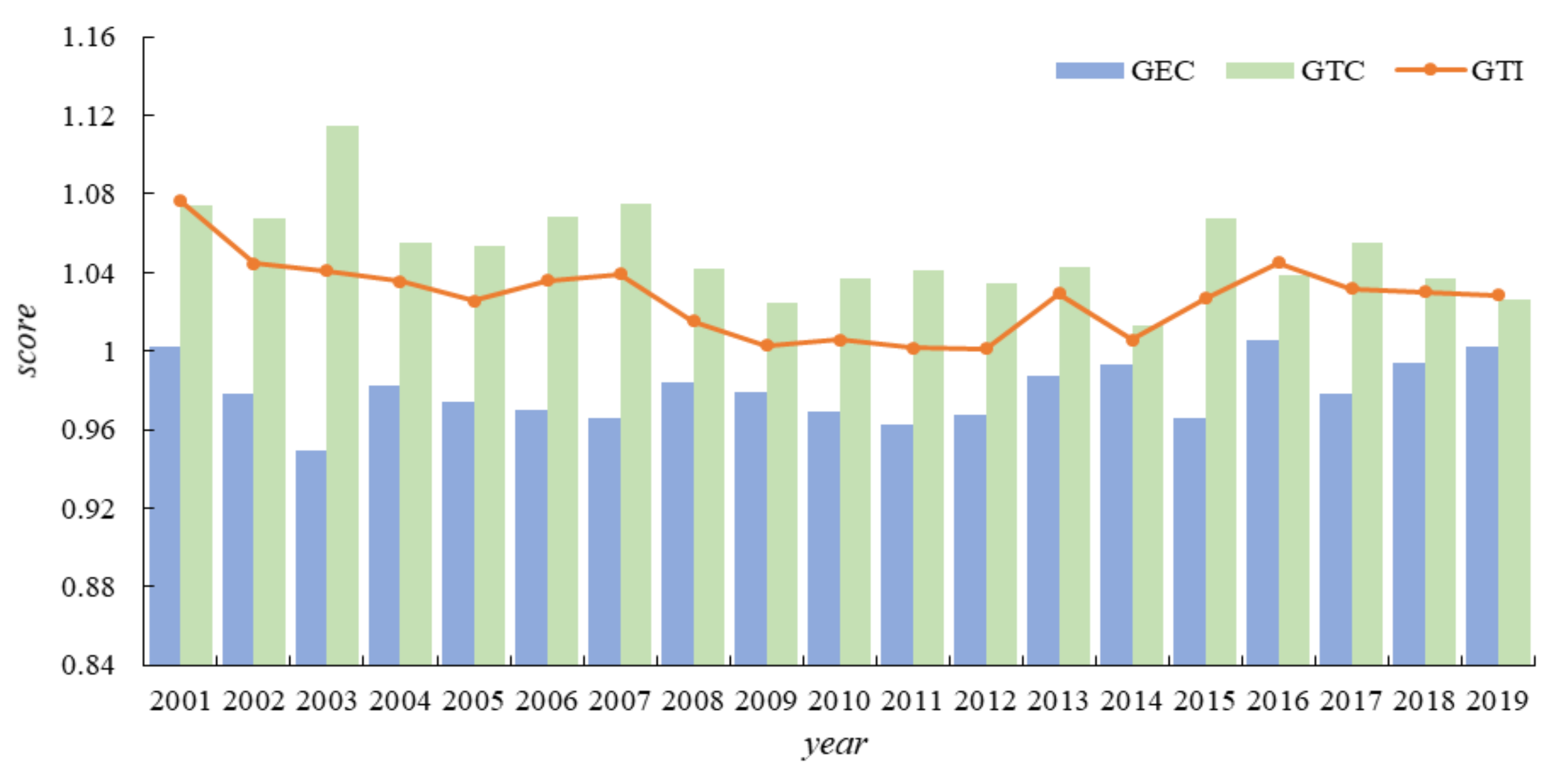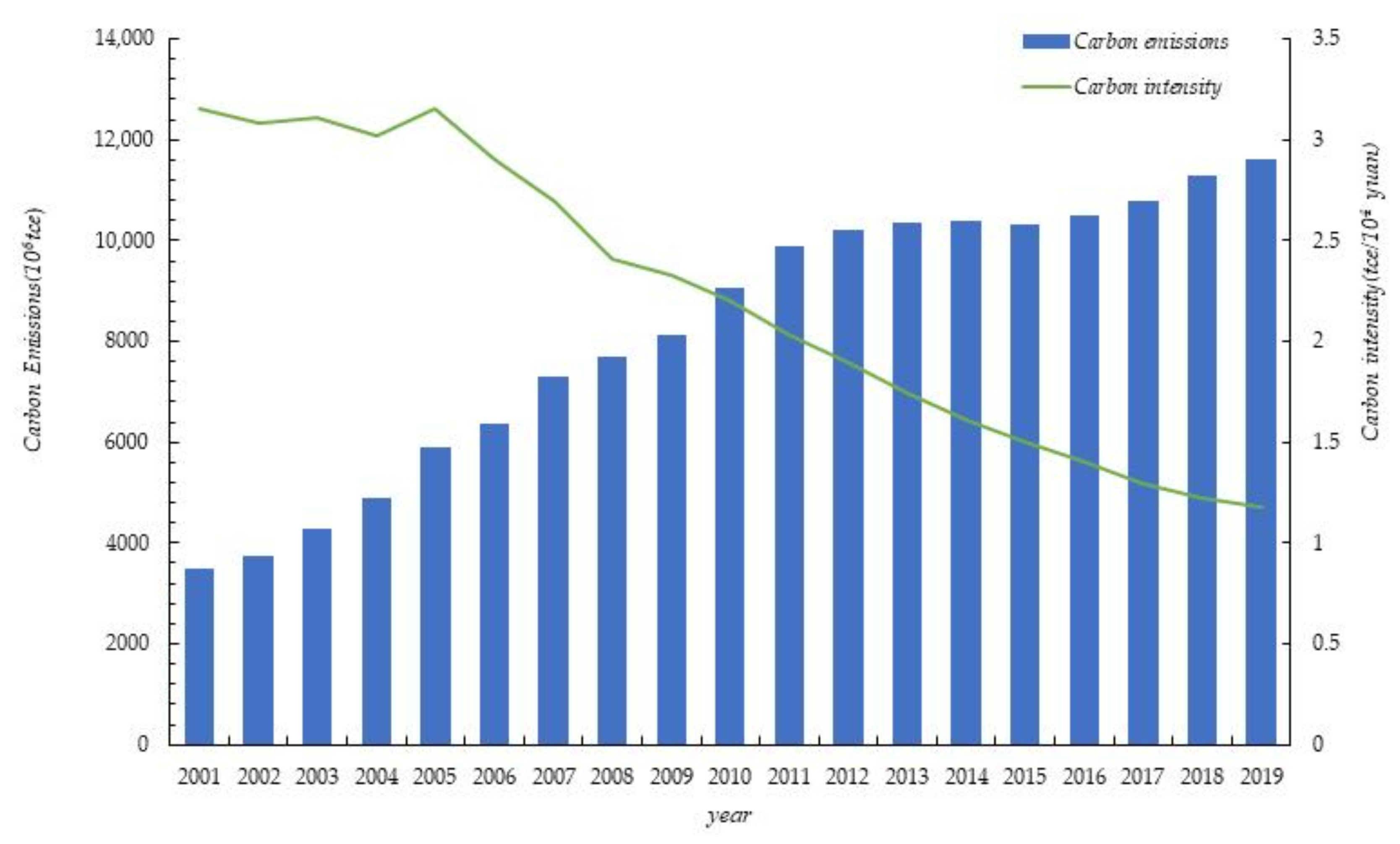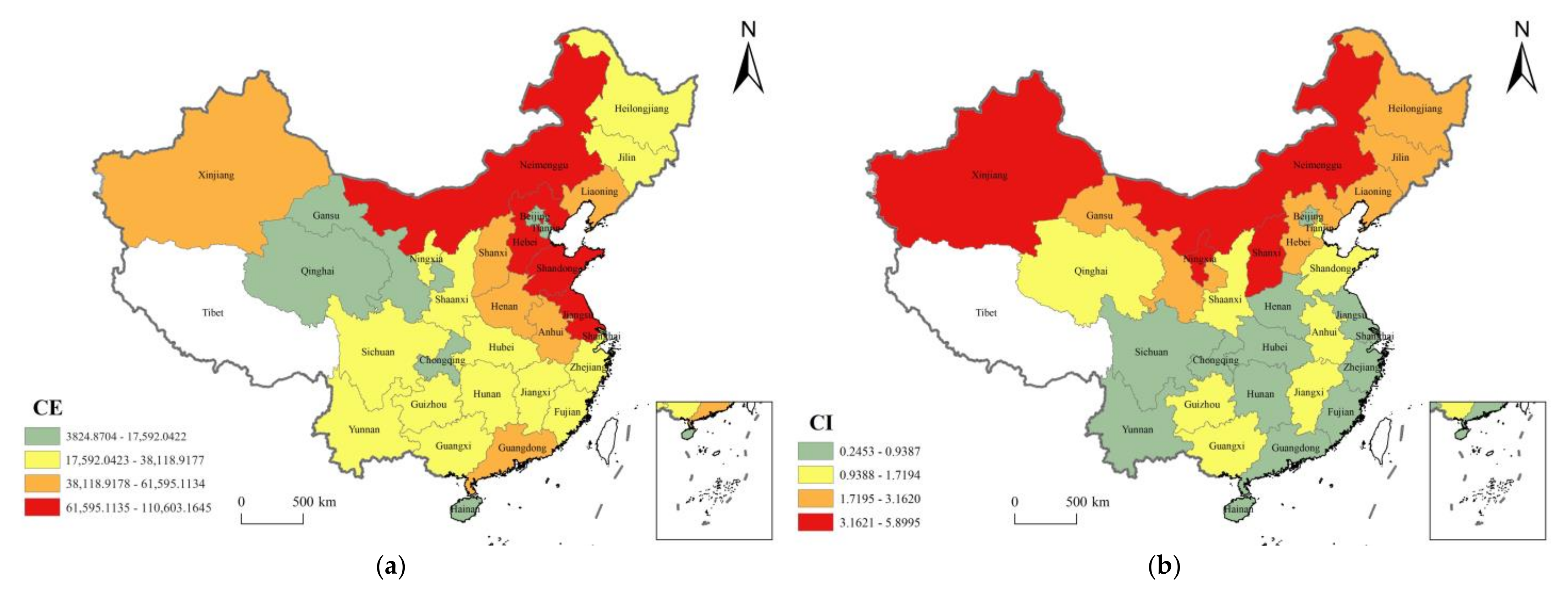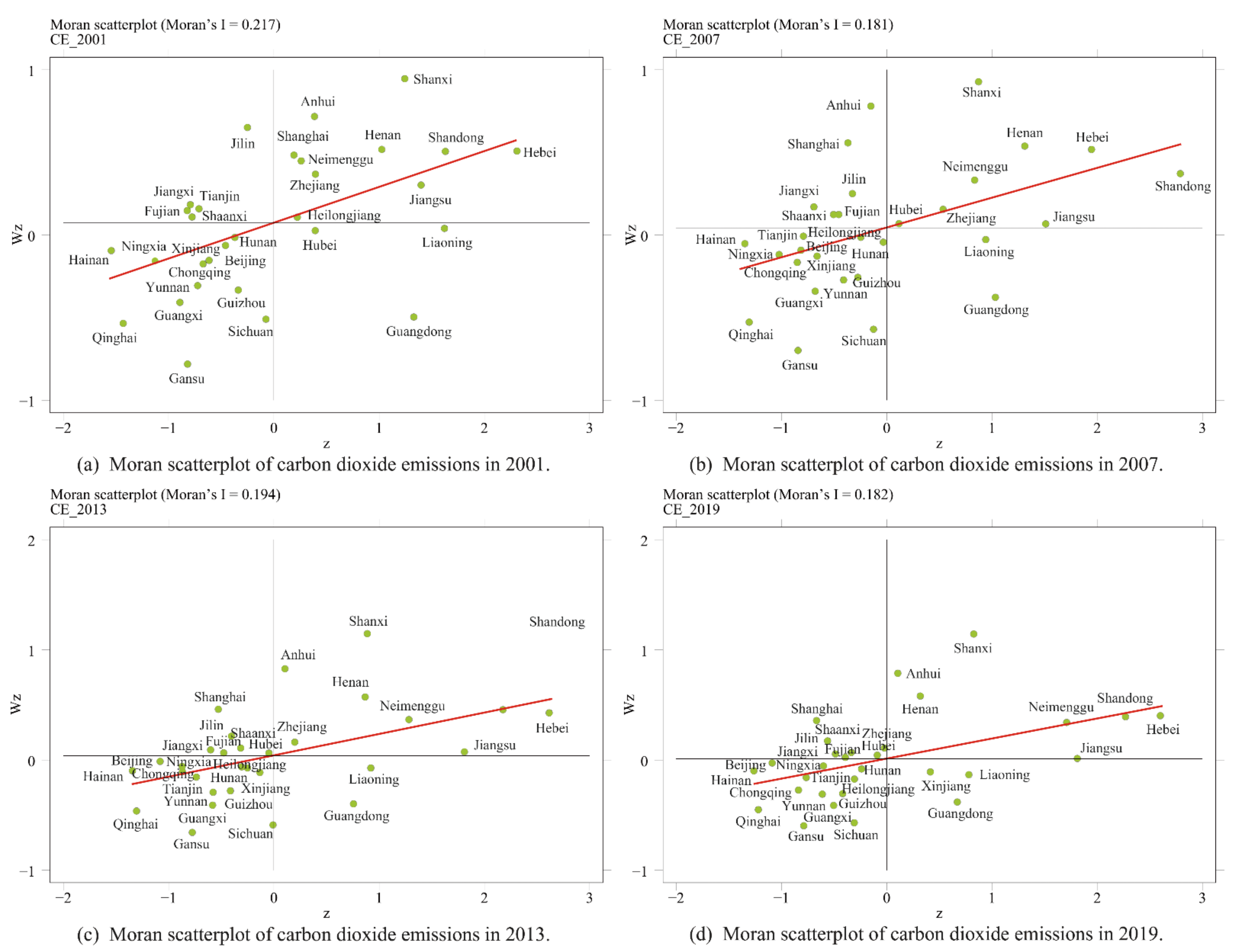1. Introduction
Over the past few decades, China’s rapid economic development has brought about a series of side effects such as resource depletion and environmental degradation, which makes the sustainable development of China’s economy and society a huge challenge [
1,
2,
3,
4,
5,
6,
7]. Carbon dioxide emissions (CDE) are a key factor in climate deterioration [
8,
9]. China, as the largest CDE producer in the world and one of the countries committed to achieving carbon neutrality and complete elimination of carbon emissions by 2060 [
10], is under tremendous pressure to reduce emissions [
10,
11,
12]. In order to curb the increase of CDE, the Chinese government has made a series of commitments and plans to promote a comprehensive shift in socio-economic development to a green development model, starting from 2021 [
13].
With the severe challenges brought about by environmental degradation, green technology innovation (GTI), as a new innovative method that highlights green environmental protection, can not only achieve economic growth, traditionally driven by traditional technological innovation, but also effectively alleviate the dual pressures of energy and the environment. This is a cause of concern for governments around the world [
14,
15,
16,
17]. GTI is an important means to alleviate the internal contradictions between economic growth and environmental pollution, and has become a key factor in promoting green and sustainable development [
18,
19]. At present, China’s economy is in a critical period of high-quality development, and promoting GTI is an important way to realize the transformation and upgrading of China’s strategic emerging industries [
20,
21]. It is also an important measure to advocate the construction of ecological civilization and high-quality economic growth [
22,
23,
24,
25].
Regional heterogeneity and spatial interconnection are essential features affecting the influence of technological innovation on the ecological environment [
26]. Owing to the existence of spatial interaction, the GTI or CDE of a region will have specific effects on the surrounding regions through diffusion or polarization. The GTI and CDE of different regions are therefore both interconnected and distinct. China has a vast territory, and each region has its own traits, ignoring the spatial spillover effect can cause biases in model estimation. As such, there is a need to conduct an in-depth study on the spatial spillover effects of both GTI and carbon emissions.
GTI is of great significance to promote carbon emission reduction and can help governments fully realize the strategic goal of carbon neutrality. However, so far, research on carbon emission factors has focused more on technological innovation and neglected the GTI, which is more closely related to carbon emission. Therefore, the aim of this research is to quantitatively analyze the levels of GTI and carbon emissions across China, explore the spatial distributing characteristics of GTI and carbon dioxide, based on which, an in-depth analysis of the spatial spillover and non-linear impact of GTI on regional CDE will be performed and relevant countermeasures and suggestions will be proposed.
The remainder of this article is structured as follows.
Section 2 reviews the literature on carbon emissions and GTI.
Section 3 explains the data sources, variable selection, and research methods.
Section 4 presents the empirical results.
Section 5 wraps up the paper and suggests further research.
2. Literature Review
As global climate change intensifies, environmental issues, together with food security, education, health, poverty, etc., have become the most pressing issues in the world [
27,
28]. An important factor leading to climate change is the emission of greenhouse gases [
8,
29], and carbon dioxide is a major component of greenhouse gases, so current concerns about carbon emissions has become a hot topic of scholars [
28,
30,
31,
32]. As the world’s largest carbon dioxide emitter [
10,
12], China contributed an average of 63.9% of the increase in global emissions from 2006 to 2016 [
12]. As a responsible major country, China proposed that it should reach the peak of CDE by 2030 and achieve the strategic goal of carbon neutrality by 2060 [
33]. Nowadays, accelerating GTI and transforming the economic development mode have become an important means to achieve carbon peaking and carbon neutrality goals, and therefore, achieve sustainable economic development [
16,
28]. It should be noted that managing to hold carbon emission peak and carbon neutrality does not blindly pursue energy conservation and carbon reduction. It aims to apply a green economic development model that can achieve harmony between humans and nature, while ensuring stable economic development, which is an economic model of sustainable development [
34]. The green economy consists of sociopolitical and economic elements, the balance of which makes an economy sustainable [
35]. In view of the current worsening ecological environment, green economy has become the economic development model pursued by all countries, and a topical research field among academia. Vukovic et al. [
35] propose main principles and a methodology of the criteria evaluation for a regional green economy and combine the current state and dynamics of the green economy in evaluating and forecasting. Pociovălișteanu et al. [
36] study a situation of green jobs at the European Union level and the relationship between environment and employment, by analyzing the link between employment and environmental policies. Dulal et al. [
37] analyze the role of financial tools in Asian countries in the process of achieving green economy. To promote a green economy and achieve sustainable economic development, the primary issue is to control greenhouse gas emissions. Therefore, it is necessary to conduct an in-depth study on reducing carbon dioxide emissions.
GTI is a term widely used in different research areas, its goal being to achieve cleaner production, improving environmental performance, and promoting the comprehensive utilization of resources and energy [
38,
39,
40,
41]. It not only emphasizes technological innovation to save resources and energy, but also requires the reduction or even elimination of pollution and damage to the ecological environment [
20]. As a new innovative method that highlights green and environmental protection, GTI can not only achieve economic growth driven by traditional technological innovation, but also alleviate the dual pressure of energy and the environment. It can therefore promote low-carbon sustainable economic development [
42,
43,
44,
45,
46]. In the literature, there is much research on the mechanism and effectiveness of specific green technologies to improve environmental performance [
47,
48,
49,
50]. For example, Diaz et al. [
51] analyzes the impact of carbon capture technology on carbon emission reduction in view of greenhouse gas emissions in the U.S. refining industry, and finds that carbon capture technology can effectively reduce carbon emissions. López et al. [
52] find that technological innovations, such as electric buses and emission-free buses, should be prioritized in order to achieve a greater performance in the environmental dimension. Green technologies, such as carbon capture, waste management, and power generation technologies, are expected to significantly alleviate the global energy, environment, and climate change crises in the future [
53,
54,
55].
For the measurement of GTI, some scholars use green patents to evaluate the level of GTI. For example, Du et al. [
56] use the number of green technology patents as the proxy variable of the level of GTI to study the impact of environmental regulations at different levels of economic development on GTI. Some authors use parametric analysis to measure the level of GTI. For example, Lv et al. [
57] measure the green total factor productivity (GTFP) of 30 provinces in China from 2003 to 2017 and find that the financial structure is conducive to GTI, while the financial scale and financial efficiency have a negative impact on GTI. Wang et al. [
17] use the GTFP decomposition index to refer to the level of GTI, and find that GTI has a positive impact on the region’s GTFP and a negative impact on the periphery. As an important part of green innovation [
58], GTI can effectively alleviate the pressure on resources and the environment in the process of promoting economic modernization [
59]. To solve the current severe climate change and environmental pollution issues, it is of great significance to study the impact of GTI on CDE.
When we consider the regional heterogeneity and spatial interconnection, traditional econometric models are inefficient [
60]. Spatial econometric models consider the spatial dependence between observations, and different approaches are used when spatial effects are considered [
61]. Among them, the spatial autoregressive model (SAR), the spatial error model (SEM), and the spatial Durbin model (SDM) are the three most commonly used spatial econometric models [
62]. Chen et al. [
26] use the SDM to examine the influencing factors of urban eco-efficiency associated with technological innovations, and find that high innovative ability can increase urban eco-efficiency. Zhang et al. [
63] use the SDM to examine the impact of high-speed rail on the consumption of urban residents, and found that HSR had different effects on consumption density in cities in eastern, central, and western China due to different levels of urban economic development and inter-city relationships. Yao et al. [
60] use the SAR, SEM, and SDM to analyze the impact mechanisms of urbanization dimensions and the internal structure effect of each dimension on eco-efficiency, and find that population and ecological urbanization have a significant positive impact on local eco-efficiency, while social and spatial urbanization have a negative impact. Chica-Olmo et al. [
64] use the SAR, SEM, and SDM to investigate the spatial dependence between GDP and renewable energy consumption for 26 European countries. Considering the existence of spatial interaction, it is of great significance to analyze the spatial spillover effect of GTI on CDE.
The existence of regional heterogeneity often lead to different results of innovation. For example, in some regions, despite favorable conditions and successful innovation factors, many attempts have failed, while in other regions, such attempts have been successful [
65]. This phenomenon can be explained by innovative susceptibility of regions. Innovative susceptibility is an economic phenomenon relevant to certain level of scientific and technological progress and market relations [
66]. Regional innovation sensitivity refers to the availability and ability of regional units to create and apply innovation based on existing conditions and resources in a specific and continuous regional innovation policy. Belyakova et al. [
66] discuss the issues related to the content of the definitions “innovative susceptibility” and “regional innovation system”, and reveal the characteristics and classification of innovative susceptibility of the region. Volkova et al. [
67] regard the innovation susceptibility of the regional economy as a condition of the digitalization of the regional economy, and propose an evaluation method of the innovation susceptibility to clarify the influence of various factors on the innovation susceptibility of the region and the pace of digital transformation. From the literature review, we can conclude that different regions differ in the degree of innovative development, owing to the innovative susceptibility. Therefore, it is necessary to conduct an in-depth analysis of the regional heterogeneity of GTI.
In the literature, there is a bulk of research on the relationship between technological innovation and carbon emissions. These studies have provided us with important references and enlightenment, but there are still some deficits. First, existing research has investigated the relationship between carbon emissions and technological innovation [
68,
69,
70,
71], but little on the GTI, which is more relevant to carbon emissions. Second, existing research on GTI focuses more on the overall research at the national level in China, but little on the regional heterogeneity of GTI, which results in a fragmentary understanding of the regional heterogeneity of GTI [
72,
73,
74]. Last, the analyses of the impact of GTI on environmental issues in the literature do not consider spatial correlation [
73,
75,
76,
77]. Considering that China is a country with significant regional differences in resource endowments, economic structures and policy environments, ignoring spatial spillover effects will inevitably lead to biased results.
The contributions of this study are threefold. First, this paper combines the SBM (Slack Based Measure) model and the GML (Global Malmquist-Luenberger) index to measure GTI by constructing an environmental pollution unexpected output, and uses the Gini coefficient to measure the regional differences of GTI. This is conducive to a clear and comprehensive understanding of the phase characteristics of China’s green technology and its regional development characteristics, and lays the foundation for subsequent research on GTI. Second, it uses the kernel density estimation method to reveal the spatiotemporal evolution characteristics of carbon emissions, which helps us to obtain a clearer understanding of the spatial distribution and evolution characteristics of CDE. Third, it focuses on the spatial spillover effects of GTI on carbon emissions, through which the spatial correlation of CDE is fully considered and the research settings are therefore more realistic.
This paper uses the SBM model and GML index to measure the GTI of China’s 30 provincial administrative regions from 2001 to 2019. It constructs a spatial panel model to analyze the spatial spillover effects and nonlinear effects of GTI on carbon emissions. Regardless of the analysis of the regional spatial distribution characteristics of GTI and CDE, or the study of GTI’s spatial spillover effects of CDE, it is an enrichment and improvement of the theoretical system of carbon emission reduction in environmental economics. This study can also help policy makers to fully consider the spatial spillover and nonlinear impact of GTI on carbon emissions, and formulate different regional policies and measures based on the development characteristics of each province.
5. Conclusions
This paper studied the impact of green technology innovation (GTI) on carbon emissions, selected relevant panel data from 2001 to 2019 for 30 provincial regions in China, and comprehensively analyzed the spatial spillover and non-linear effects of GTI on carbon emissions. The main findings are the following.
First, China’s GTI has developed steadily and has achieved growth over the previous years. Among them, China’s green technology progress has improved significantly, but the innovation efficiency is not high, indicating that in the process of promoting GTI, China has paid too much attention to the extent of technological progress, but little to the importance of innovation efficiency. This not only causes the waste of human and material resources, but also leads to the low level of China’s overall green innovation.
Second, China’s total carbon dioxide emissions (CDE) have grown at a marginal rate of decline, and the intensity of carbon emissions has been declining year by year, indicating that China has achieved phased success in controlling CDE. However, at the current stage, China’s carbon emissions in various regions still have the regional development imbalances problem.
Third, GTI cannot only effectively reduce CDE in the region, but also have a significant spatial spillover effect on the reduction of CDE outside the region. From the perspective of the overall trend, as the development level of the economy increases, the effect of GTI on carbon emission reduction has weakened. A possible reason is that when the economy is highly developed, the marginal reduction in emissions from investing capital in GTI is diminishing.
Based on the above conclusions, our recommendations are as follows:
- (1)
In the process of increasing investment in GTI, each region should strive to improve the efficiency of technological innovation. At the same time, in view of the differences in regional economic development and carbon emissions, relevant regional policies and measures should be formulated in accordance with local conditions.
- (2)
From the perspective of the temporal and spatial distribution characteristics of China’s CDE, the government should coordinate regional development characteristics, accelerate the transformation and upgrading of the regional industrial structure, achieve coordinated planning for regional development, and promote coordinated regional development.
- (3)
In the process of formulating policies, local governments need to pay attention to both the production and development of the region, and the development strategies of the surrounding areas, and actively build a regional collaboration platform to promote the coordinated development of green multi-regional technological innovation and energy conservation and emission reduction.
- (4)
Taking into account the threshold characteristics of GTI, only by continuously increasing R&D expenditures on GTI and promoting the continuous development of GTI can regions effectively achieve the reduction of carbon dioxide and ensure the successful realization of carbon peak and carbon neutral goals.
Finally, it is worth pointing out that this paper attempted to provide new evidence on the heterogeneous impact of GTI on CDE, whereas measuring GTI is a challenging issue. Due to the data availability, we employed GTFP as the proxy of the GTI that has some potential limitations. Future research will aim to find ways to better measure GTI. Of course, the limitations do not cast doubt on the results of this study, but they should be addressed in future studies. In addition, in the study of regional differences, we can focus on the analysis of the innovative susceptibility of regions in the future. This can help us to obtain the sensitive differences in GTI from development to application in different regions, and play an important role in achieving regional joint reduction of carbon emissions.















